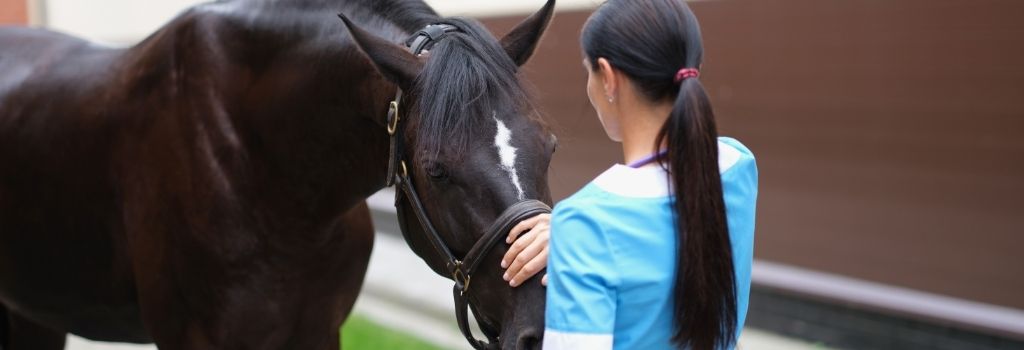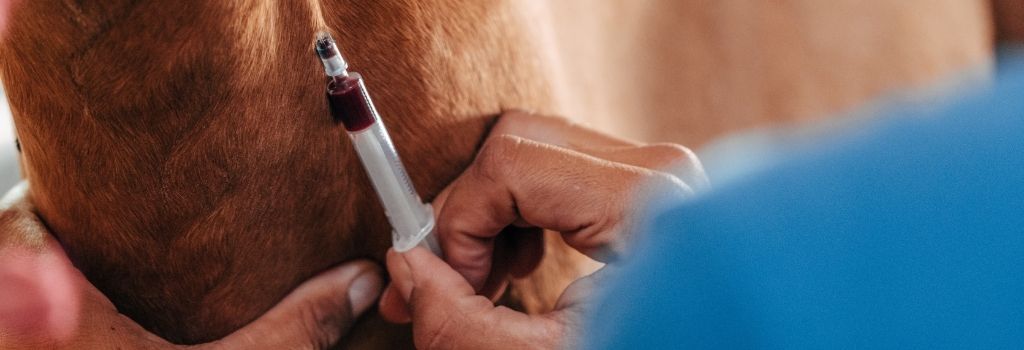Just like household pets, horses require regular wellness exams to ensure they’re maintaining optimal health and living the highest quality of life possible. It’s recommended that horses have a visit from their veterinarian twice annually to confirm their physical parameters are normal and also to administer vaccines and dewormers. Horse wellness exams are slightly more comprehensive than those given to household pets due to their outdoor living environment and participation in shows—both of which come with additional exposure that could impact their health.
Wellness Exam Process
The physical examination of a horse includes a nose-to-tail evaluation, including vital signs, listening to the heart and lungs, listening to gut sounds, checking gum color and capillary refill time, and carefully looking at the eyes, legs, feet, and body for a body condition score. In addition, an oral exam will be conducted to make sure the teeth are properly floated, and the horse’s mouth is comfortable.

In addition to a physical examination, vaccines will be administered based on your horse’s exposure and geographic area. Veterinarians recommend core vaccines for every horse and risk-based vaccines such as strangles, influenza, and equine equine herpesvirus, depending on their lifestyle, diet, and exposure to pathogens.
It’s important that any issues you’ve noticed as the horse owner are addressed during a wellness exam, such as being slow to shed which could indicate an endocrine disorder, dropping feed which could signify a dental issue, or being footsore which might require x-rays to assess coffin bone configuration.
Additional Testing
Additional steps taken as the result of a horse wellness exam depend on the specific horse and the veterinarian’s findings from the physical examination. For example, if they appear too thin or too heavy, blood tests may be recommended to provide a better understanding of their overall health. X-rays may also be ordered if there are any signs of injury, joint issues, or lameness. Learn more about the equine X-ray process from Tufts' Cummings School of Veterinary Medicine.
Environmental Factors
Living conditions can impact a horse’s overall wellness, considering outdoor elements such as rain, cold, and humidity. The condition of bedding, stalls, and pastures can also impact wellness. Horses that spend most of their time outside in a wet environment tend to have trouble with their feet due to the constant damp ground. For these reasons, a visiting veterinarian will want to inspect the horse’s living environment during a wellness exam to ensure they have access to a dry space and dry bedding.

Early Detection
The most important reason to make sure your horse is receiving regular wellness exams is for the sake of early detection. The quicker an issue is discovered and treatment can begin, the more likely your horse is to make a full recovery. It is also far easier to treat an illness in its early stages versus something that has been given time to reach an advanced stage. The goal of equine veterinary medicine is always prevention and early detection to avoid unnecessary pain and discomfort for your horse.
Wellness Exams for Geriatric Horses
Geriatric horses need extra attention during wellness exams due to the greater likelihood of illness and disease—especially endocrine and metabolic diseases. Bloodwork is especially important at this stage of a horse’s life, so it can be compared to baselines as an indicator of any organ function changes that need to be addressed. A veterinarian will also continue to administer vaccinations to senior horses. It’s a long-held myth that older horses develop immunity to diseases due to regular vaccination throughout their lives. The reality is that their compromised immune systems actually make them more susceptible to diseases.
Don't have a vet in your area yet? We can help you find a local veterinarian.
If you have more questions, the GeniusVets Telehealth platform will give you unlimited access to text and/or video calls with board-certified veterinarians! To learn more click here.
